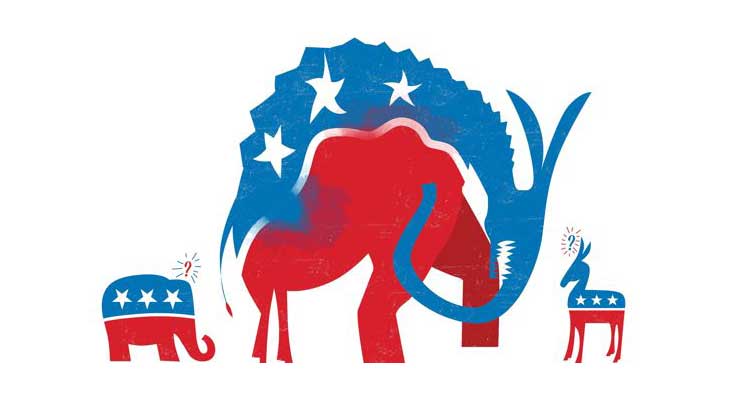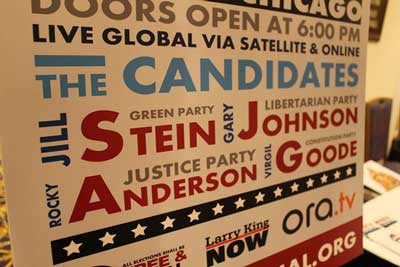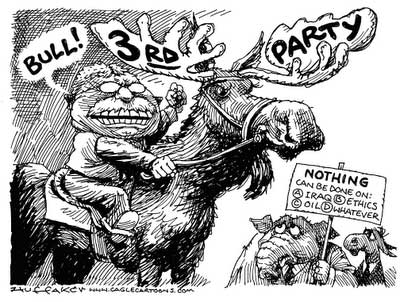
This is the second of seven posts on Electoral Strategy.
One of the most powerful achievements of the two-party system has been to effectively limit political competition in a nation still widely regarded as a democracy. These limits are enforced by law and procedure but are also the results of the strategy of Triangulation.
Triangulation proclaims: “there is no alternative,” and works to enforce that claim. This strategy has demobilized a near majority of US voters into non-voters and induced a significant minority to knowingly vote for parties that do not represent their views or interests.
Triangulation took its most coherent form under the Clintons but it really describes the relationships between the Democrats and social movements since the 1970s at least. The Republicans play the same game.
Triangulation is a war of position.
The Democrats position themselves to the right of the labor and social movements, and it could well be argued, of the majority of Democratic voters. Democratic strategy targets ‘swing voters” or “swing states” standing between Democrats and Republicans. Mainstream Democrats don’t bother with a direct appeal to the social movements or non-voters because that would risk unleashing forces of social change — and because they don’t have to.
 The first Obama campaign was a partial and momentary departure from this and proved the potential for mobilizing occasional voters and new voters by what seemed a visionary call for change. Even conservative unions switched their Clinton t-shirts for Obama ones.
The first Obama campaign was a partial and momentary departure from this and proved the potential for mobilizing occasional voters and new voters by what seemed a visionary call for change. Even conservative unions switched their Clinton t-shirts for Obama ones.
But most of the time the movement votes are signed, sealed and delivered without real pressure or public criticism. Some political critics and activists even take a holiday during the election cycle for fear of damaging Democratic prospects. They surrender the rights to open debate or make demands in the name of some clever tactic to defeat the right-wing. In 2000 the call for “Anyone but Bush” failed and such tactics fail to improve public debate and actually risk losing elections.
We should never leave the Democrats free to tailor their appeal to the small percentage of voters undecided between them and the Republicans because it draws them, and us, toward the so-called “center,” and narrows the terms of political debate. Take the 2012 presidential election for example, when the war in Afghanistan and the environmental crisis were effectively non-issues.
Mid-term elections, in particular, are revealing as to how triangulation strengthens the right-wing. Once incumbency relieves national Democratic leaders of the any need to lean toward their “base,” triangulation comes in full swing. In 2014 for example, triangulation led to electoral disaster for Democrats and the lowest voter turnout in 70 years despite the record $4 billion spent on the election.
With few exceptions, 2014 offered the choice between pseudo-Republicans on the Democratic ticket and real Republicans. Voters choose the real deal and/or the demoralized voters stay home.
Triangulation sharply curtailed Obama possibilities. This is not a new pattern. Triangulation did its share to contribute to the right-wing resurgence and entrenchment in 1994, 1996, 2010 and 2014.[2]
Michael Lerner’s analysis of 2010 points to the long-term effect of triangulation.
We know, of course, that the Democrats did not have a solid majority in Congress, given Rahm Emanuel’s 2006 decision to back the most conservative candidates in the Democratic primaries in order to win in swing districts and take Democratic control of the House of Representatives (a decision he made while serving as chair of the Democratic Congressional Campaign Committee). Democrats in the Senate followed a similar path. As a result, they won formal control and hence could be blamed for what ensued, but they did not have the votes to fulfill their promise to the electorate to cut off funding for the war in Iraq.
When machine Democrats steal the thunder from Republicans, as the Clintons were infamous for, the Republicans are pushed further rightward to redefine their appeal, mark their territory, and secure their voting base. By becoming another party of Wall Street, the Democrats have relieved the Republicans of much of their historic mission.
What’s a Republican to do? Move to the right!
 It was after all the Clinton administration whose “tough on crime” stance outmaneuvered the Republicans and produced the largest increases in the state and federal prison population of any president in history.[1] Clinton militarized the police with as much zeal as his right-wing predecessor. Triangulation created the American gulag. NAFTA, too. “Ending welfare as we know it” was a signature accomplishment of the Clinton White House as well as a priority for Republicans. Both parties lead their attack on the poor with moralistic calls for “personal responsibility.”
It was after all the Clinton administration whose “tough on crime” stance outmaneuvered the Republicans and produced the largest increases in the state and federal prison population of any president in history.[1] Clinton militarized the police with as much zeal as his right-wing predecessor. Triangulation created the American gulag. NAFTA, too. “Ending welfare as we know it” was a signature accomplishment of the Clinton White House as well as a priority for Republicans. Both parties lead their attack on the poor with moralistic calls for “personal responsibility.”
When Democrats protect big banks, Republicans are free to attack unions. When Democrats coddle big oil, coal, and gas, the Republicans resort to climate denial and gag rules. TPP is a bipartisan project of the center.
Here is how the Guardian describes the ideas of George Lakoff, the cognitive linguist:
“[T]he left, he argues, is losing the political argument – every year, it cedes more ground to the right, under the mistaken impression that this will bring everything closer to the centre. In fact, there is no centre: the more progressives capitulate, the more boldly the conservatives express their vision, and the further to the right the mainstream moves.”
Just how badly can public debate be twisted? If Obama can be attacked as an anti-war president then reality is no measure.
If there is a bottom to the depths we have not marked it yet.
So every four years we are served up a full course menu of Republican horribles. Stampeded by revulsion and fear, we are left with the choice of voting for mainstream and right-wing Democrats whose strategy then enables the further rightward drift of both parties. Or, so it has been for a half a century. Triangulation has contributed its share to the dramatic rightward shift in the Republican Party.
But, for many mainstream politicians in high places, finishing second in the richest, most powerful country in the world is not so bad. Two-party triangulation limits risk because the “loser” is guaranteed a comfortable place at the table.
The major parties leaders really have no skin in the game.
As long as triangulation works to reproduce power unchanged, then the social movements largely miss out on the political opportunities that elections should present.
[1] Michele Alexander, The New Jim Crow: Mass Incarceration in the Age of Colorblindness, 56-57
[2] To see the similarities between 2014 and 2010 see Roger Hickeyhttps://ourfuture.org/20141120/as-in-2010-dems-lost-without-an-economic-message-worth-fighting-for 2010 election was notable for low democratic turnout and the Democrats retreat from stimulus, job creation, caving to the Republicans on budgets, and unwillingness to tout health care reform. It was long term triangulation at work to support right wing Democrats.
It was the right-wing “Blue Dog” Democrats that lost big. See Amanda Terkel https://www.huffingtonpost.com/2010/11/03/blue-dog-coalition-gop-wave-elections_n_778087.html See also: https://www.democracynow.org/2010/11/4/as_right_leaning_blue_dogs_lose
Almost as extreme was the 1994 mid-term elections with the Democrats adhering to triangulation under Bill Clinton. In 1994 and 1996 Congress was elected by less than 25% of the eligible electorate. See Kay Lawson, “ The Case for a Multiparty System,” p. 34 in Multiparty politics in America second Edition, Eds. Paul s. Herrson and John C. Green
Leave a Reply